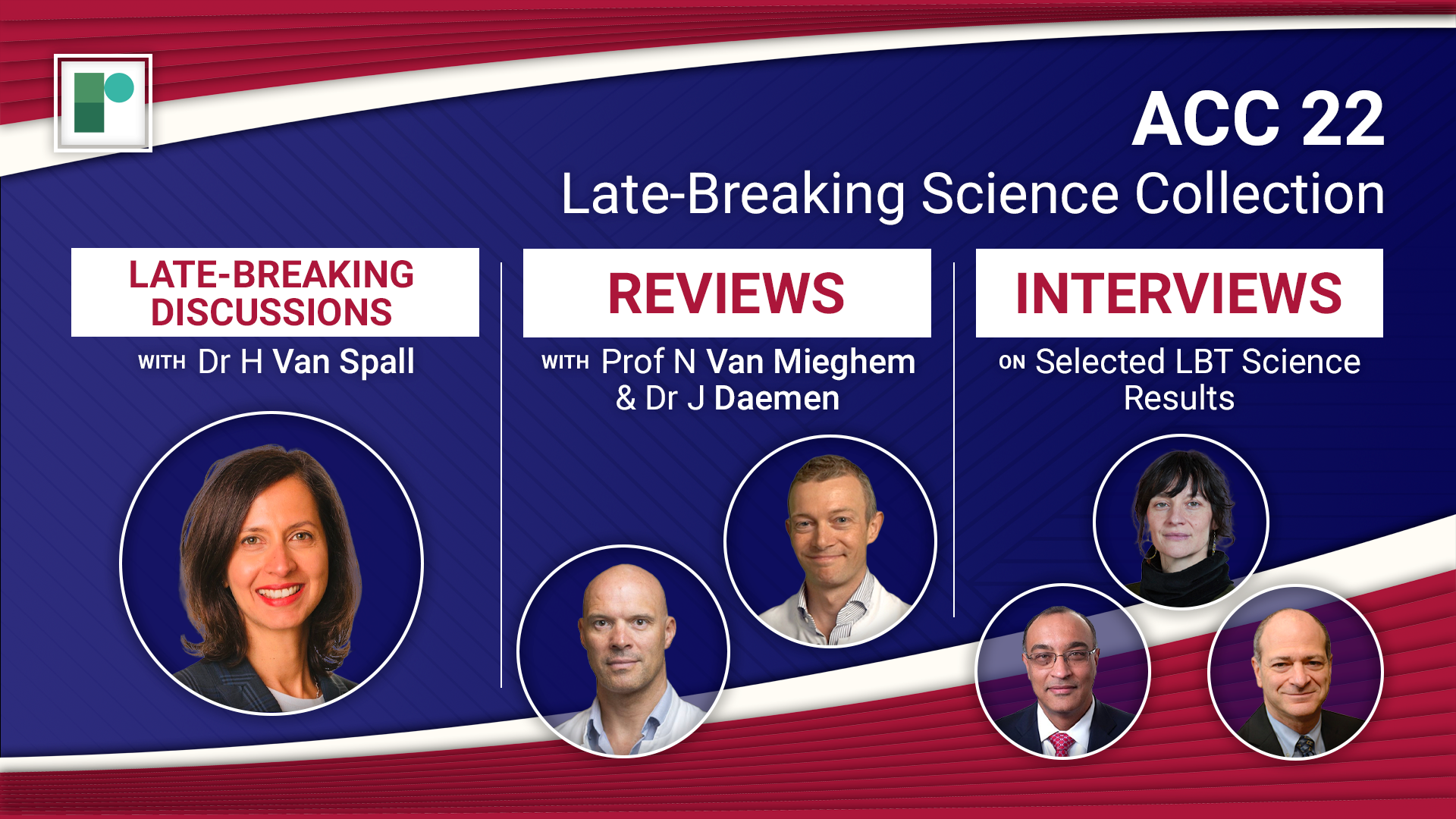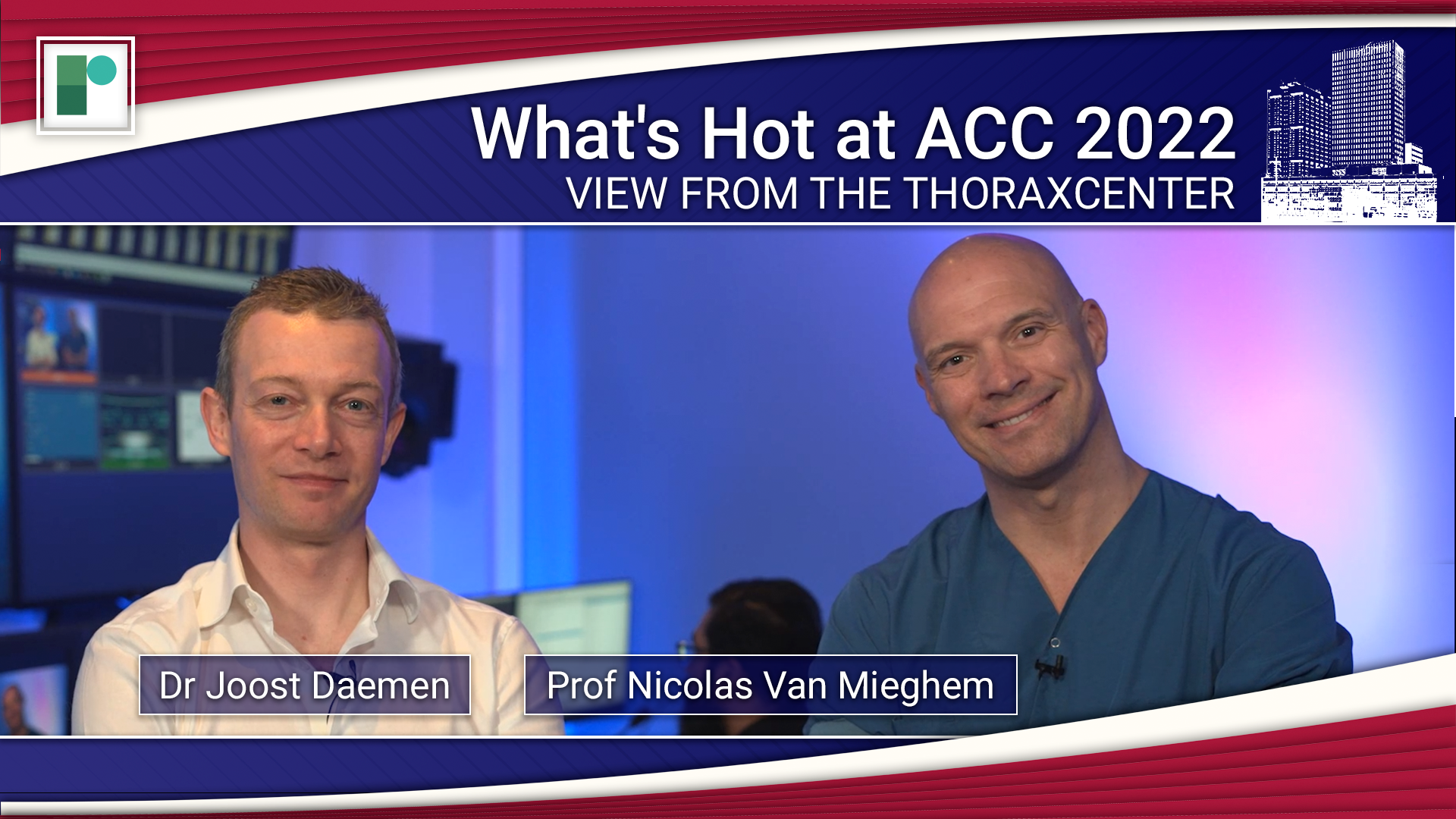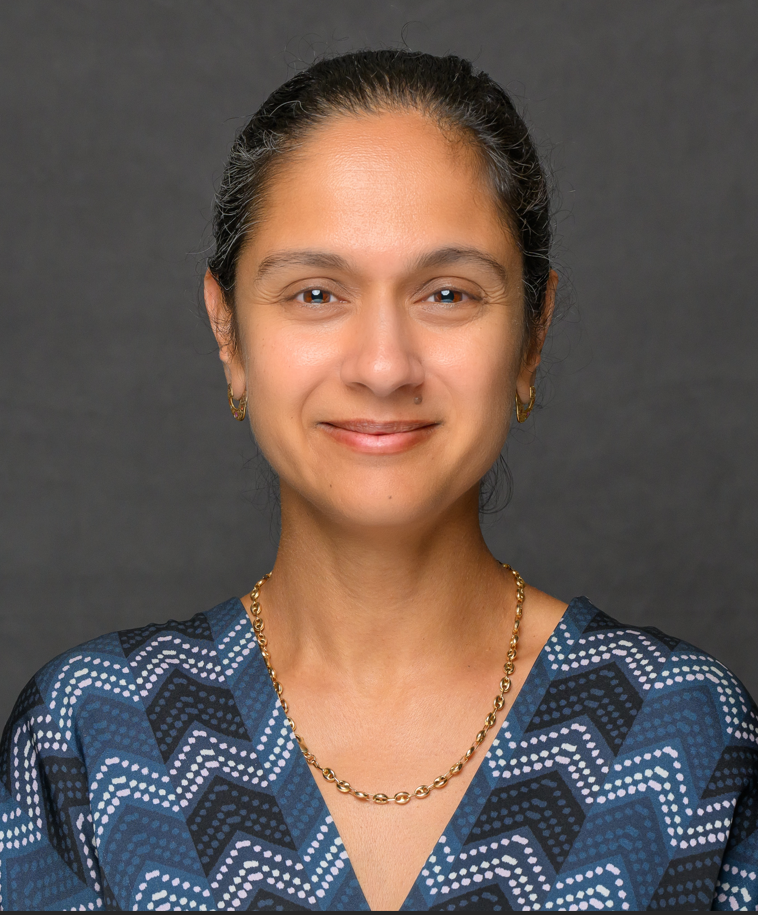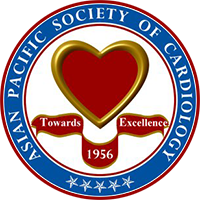ACC 2022: Late-breaking Science Video Collection
Published: 05 April 2022
-
Views:
 7618
7618
-
Likes:
 7
7
-
Views:
 7618
7618
-
Likes:
 7
7
-
 12m 6sPart 4 | Session 1 ACC 22: 3 Trials That Will Change Your Practice with Dr Purvi Parwani
12m 6sPart 4 | Session 1 ACC 22: 3 Trials That Will Change Your Practice with Dr Purvi Parwani -
 6m 15s
6m 15s -
 7m 9sPart 4 | Session 3 4 Lipid Late-breaker Highlights from ACC.22 with Dr Erin Michos
7m 9sPart 4 | Session 3 4 Lipid Late-breaker Highlights from ACC.22 with Dr Erin Michos
-
 23m 9sPart 1 | Session 1 ACC 22 Late-breaking Science Preview Nicolas M Van Mieghem, Joost Daemen
23m 9sPart 1 | Session 1 ACC 22 Late-breaking Science Preview Nicolas M Van Mieghem, Joost Daemen
-
 28m 6sPart 1 | Session 2 ACC.22 Late-breaking Science Wrap-Up Nicolas M Van Mieghem, Joost Daemen
28m 6sPart 1 | Session 2 ACC.22 Late-breaking Science Wrap-Up Nicolas M Van Mieghem, Joost Daemen
-
 16m 42sPart 2 | Session 1 ACC 2022 Late-breaker Discussion: The SODIUM-HF Trial Justin Ezekowitz, Harriette Van Spall
16m 42sPart 2 | Session 1 ACC 2022 Late-breaker Discussion: The SODIUM-HF Trial Justin Ezekowitz, Harriette Van Spall
-
 16m 57sPart 2 | Session 2 ACC 2022 Late-breaker Discussion: The SuperWIN Trial Harriette Van Spall, Dylan L Steen
16m 57sPart 2 | Session 2 ACC 2022 Late-breaker Discussion: The SuperWIN Trial Harriette Van Spall, Dylan L Steen
-
 15m 38sPart 2 | Session 3 ACC 22 Late-breaker Discussion: The PROMPT-HF Trial Harriette Van Spall, Gregg C Fonarow, Tariq Ahmad
15m 38sPart 2 | Session 3 ACC 22 Late-breaker Discussion: The PROMPT-HF Trial Harriette Van Spall, Gregg C Fonarow, Tariq Ahmad
-
 22m 47sPart 2 | Session 4 ACC 22 Late-breaker Discussion: The DIAMOND Trial Harriette Van Spall, Javed Butler, Faiez Zannad
22m 47sPart 2 | Session 4 ACC 22 Late-breaker Discussion: The DIAMOND Trial Harriette Van Spall, Javed Butler, Faiez Zannad
-
 9m 38sPart 3 | Session 1 ACC 22: Findings from the VALOR-HCM Trial Milind Y Desai
9m 38sPart 3 | Session 1 ACC 22: Findings from the VALOR-HCM Trial Milind Y Desai
-
 7m 19sPart 3 | Session 2 ACC 22: MAVA-LTE Shows Improvement in NYHA Class in Patients Treated with Mavacamten Florian Rader
7m 19sPart 3 | Session 2 ACC 22: MAVA-LTE Shows Improvement in NYHA Class in Patients Treated with Mavacamten Florian Rader
-
 3m 19sPart 3 | Session 3 ACC 22: Results From the PACIFIC AF Trial Manesh R Patel
3m 19sPart 3 | Session 3 ACC 22: Results From the PACIFIC AF Trial Manesh R Patel
-
 3m 6sPart 3 | Session 4 ACC 22: FAME 3 Suggests CABG Outperforms FFR-Guided PCI in Patients with Multivessel Disease Frederik Zimmermann
3m 6sPart 3 | Session 4 ACC 22: FAME 3 Suggests CABG Outperforms FFR-Guided PCI in Patients with Multivessel Disease Frederik Zimmermann
-
 3m 54sPart 3 | Session 5 ACC 22: Results from the TRANSLATE-TIMI 70 Trial Brian Bergmark
3m 54sPart 3 | Session 5 ACC 22: Results from the TRANSLATE-TIMI 70 Trial Brian Bergmark
-
 4m 22sPart 3 | Session 6 ACC 22: Results from the POISE-3 Trial Philip J Devereaux
4m 22sPart 3 | Session 6 ACC 22: Results from the POISE-3 Trial Philip J Devereaux
-
 6m 30sPart 3 | Session 7 ACC 22: ICD Shock Therapies and the Burden of Ventricular Tachycardia Paolo Della Bella
6m 30sPart 3 | Session 7 ACC 22: ICD Shock Therapies and the Burden of Ventricular Tachycardia Paolo Della Bella
-
 6m 3sPart 3 | Session 8 ACC 22: PACMAN-AMI Shows Reduced Plaque Regression in AMI Patients Treated with Alirocumab Lorenz Räber
6m 3sPart 3 | Session 8 ACC 22: PACMAN-AMI Shows Reduced Plaque Regression in AMI Patients Treated with Alirocumab Lorenz Räber
-
 3m 31sPart 3 | Session 9 ACC 22: Magnitude & Duration of Effects of a siRNA Targeting Lp(a) Steven E Nissen
3m 31sPart 3 | Session 9 ACC 22: Magnitude & Duration of Effects of a siRNA Targeting Lp(a) Steven E Nissen
-
 4m 48sPart 3 | Session 10 ACC 22: Results From a sub-study of the POISE-3 Trial Maura Marcucci
4m 48sPart 3 | Session 10 ACC 22: Results From a sub-study of the POISE-3 Trial Maura Marcucci
-
 2m 55sPart 3 | Session 11 ACC 22: Findings from the CoreValve US Pivotal & SURTAVI Trials Michael J Reardon
2m 55sPart 3 | Session 11 ACC 22: Findings from the CoreValve US Pivotal & SURTAVI Trials Michael J Reardon
-
 7m 44sPart 3 | Session 12 ACC 22: ADAPT-TAVR Shows SLT Does Not Affect CO for Patients After TAVR Duk-Woo Park
7m 44sPart 3 | Session 12 ACC 22: ADAPT-TAVR Shows SLT Does Not Affect CO for Patients After TAVR Duk-Woo Park
-
 5m 41sPart 3 | Session 13 ACC 22: Results From the Chocolate-Touch Study
5m 41sPart 3 | Session 13 ACC 22: Results From the Chocolate-Touch Study
-
 2m 25sPart 3 | Session 14 ACC 22: Results from the GIPS-IV Trial Pim van der Harst, Marie-Sophie de Koning
2m 25sPart 3 | Session 14 ACC 22: Results from the GIPS-IV Trial Pim van der Harst, Marie-Sophie de Koning
-
 9m 27sPart 3 | Session 15 ACC 22: FFR vs. IVUS-guided PCI in Intermediate Coronary Artery Stenosis: The FLAVOUR Trial Bon-Kwon Koo
9m 27sPart 3 | Session 15 ACC 22: FFR vs. IVUS-guided PCI in Intermediate Coronary Artery Stenosis: The FLAVOUR Trial Bon-Kwon Koo
-
 5m 35sPart 3 | Session 16 ACC 22: Results From the EMPULSE Study – Empagliflozin Proves Beneficial for Patients With HF Mikhail Kosiborod
5m 35sPart 3 | Session 16 ACC 22: Results From the EMPULSE Study – Empagliflozin Proves Beneficial for Patients With HF Mikhail Kosiborod
-
 10m 24sPart 3 | Session 17 ACC 22: Secondary Analysis of CANTOS Finds LDL & HDL Predict Residual Risk of Atherosclerotic Events Paul M Ridker
10m 24sPart 3 | Session 17 ACC 22: Secondary Analysis of CANTOS Finds LDL & HDL Predict Residual Risk of Atherosclerotic Events Paul M Ridker
-
 3m 50sPart 3 | Session 18 ACC 22: 3-year Efficacy Outcomes from the SPYRAL HTN-ON MED Med Pilot Study Felix Mahfoud
3m 50sPart 3 | Session 18 ACC 22: 3-year Efficacy Outcomes from the SPYRAL HTN-ON MED Med Pilot Study Felix Mahfoud
Overview
Our regular review series View from the Thoraxcenter hosted by Prof Nicolas Van Mieghem and Dr Joost Daemen (Thoraxcentre, Erasmus MC, Rotterdam, NL) provide a concise analysis of the late-breaking science results and spotlight impactful data.
For a deeper dive into key clinical trial data, Dr Harriette Van Spall (McMaster University, Hamilton, CA)talks with principal investigators in her regular Late-Breaker Discussion Series.
Short, accessible Expert Interviews were conducted with select faculty focusing on the results, applicability, and impact on future research.
More from this programme
Part 1
View from the Thoraxcenter
Part 2
Late-breaker Discussion Series
Part 3
Expert Interviews
Faculty Biographies

Michelle Kittleson
Cardiologist & Professor of Medicine
Dr Michelle Kittleson is Professor of Medicine at Cedars-Sinai and Director of Education in Heart Failure and Transplantation at the Smidt Heart Institute. She graduated from Harvard College and received her medical degree from Yale University. She completed residency training at Brigham and Women's Hospital and cardiology fellowship at Johns Hopkins, where she also received a PhD in Clinical Investigation.
Dr Kittleson is Interim Editor-in-Chief of the Journal of Heart and Lung Transplantation, on writing committees for the ACC/AHA Hypertrophic Cardiomyopathy Guidelines and the ACC/AHA/HFSA HF Guidelines, Co Editor-in-Chief for the ACC Heart Failure Self-Assessment Program, and on the Board of Directors for the Heart Failure Society of America. Her essays have appeared in the New England Journal of Medicine, Annals of Internal Medicine…
Transcript
Highlights of the New 2022 AHA/ACC/HFSA Guideline for the Management of HF
So I'm particularly excited about four advances in the new guidelines. Number one, I think it's fantastic that the categorization of ejection fraction includes the 41 to 49% particularly, making a special category and distinction for heart failure with improved ejection fraction, because it's so important to follow your patient's trajectories, and if you achieve success, improvement and ejection fraction, don't stop the guideline directed medical therapy that likely got them there. Which leads me to my second advance that I'm very excited about, which is the fact that the guidelines truly support and celebrate the importance of quadruple therapy, the four essential pillars of guideline directed medical therapy best given with an angiotensin receptor neprilysin inhibitor, evidence based beta blocker, mineralocorticoid antagonist and SGLT2 inhibitor. The third area I'm very excited about is cardiac amyloidosis, which has now been given an entire section in the new guidelines for diagnosis and treatment really indicating how important this has become in the field of cardiology, with under recognised prevalence with ease of diagnosis, non-invasively for TTR amyloidosis and now an FDA approved therapy to improve survival and reduce heart failure hospitalizations in patients with amyloidosis. And finally, I'm so excited that the new guidelines include value statements for many therapies, balancing the costs and the benefits. And in addition, focuses on vulnerable populations and disparities and strategies to a improve them.
Strategies that can Help Clinicians to Incorporate the Recommendations into Clinical Practice
You know, I think a guideline document can be very daunting over a hundred pages, almost 200 recommendations, countless tables, figures. How do you navigate this? So I have a strategy. Number one, whenever you see a new guideline document, read the top 10 take home messages that tell you what the architects of the guideline found most important. Number two, look through the table of contents get a sense of what's actually in there. Number three, look at the tables and the figures, so high yield for diagnostic therapeutic algorithms. Then the next time you're faced with a patient, you don't know what to do. You know that your answer may be in the guidelines, use the search function, thank goodness for the search function and hone in on the area it can help you. I think if you use the guidelines as your trusted and reliable resource of how to care for patients and know to feel comfortable going to them, you will more easily incorporate them in your clinical practice.
Barriers and Opportunities
You know, there's no question that there exists therapeutic inertia on the part of clinicians, on the part of patients, on the part of systems. But I would say whenever you encounter a patient with heart failure the most important questions to ask yourself are if this is heart failure with improved ejection fraction, make sure you don't stop guideline directive medical therapy. If there's a patient with heart failure with reduced EF are they on the four essential pillars? And if not, why not? If this patient has a preserved ejection fraction, am I missing cardiac amyloidosis? And with every patient, is there something I can do as their clinician to assist with these issues of disparity and improve their lives.







